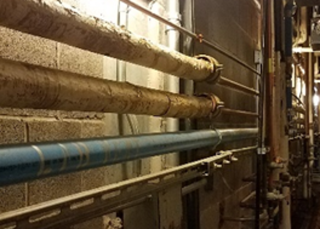Plumbing Volume Estimator Tool

Create a plumbing map to pinpoint sources of lead
The Plumbing Volume Estimator Tool allows users to generate a plumbing map for a home or building. A plumbing map includes all the various plumbing materials in a home or building along a specific water flow route. The tool was developed in support of technical assistance efforts for lead service line identification provided by EPA’s Office of Research and Development.
This tool may be useful for multiple users:
- Water system personnel
- Tribal, state, and territory personnel
- Consultants
- Individuals
Applications

There is no safe level of lead, so identifying lead plumbing sources is important to protect the health of people drinking the water.
Using the Plumbing Map
The tool generates volumes of water associated with different plumbing materials entered by the user.
- A plumbing map can tailor meaningful water sampling for lead or other contaminants, rather than relying on a set single volume.
- A plumbing map can be used to understand how much water to flush through the tap as part of proactive general flushing, after periods of no water use.
- A plumbing map can reduce uncertainty in identifying lead sources in water from traditional sampling methods, such as sequential sampling. This increases the chances of capturing the entire service line and any stagnant water with potential lead during the sampling.
Applying the Results
The tool can help users understand the volume of water contained within a length of plumbing, such as the volume of water in the pipes from a faucet to the water main.
- After water sits unused for a long period, collected samples from different plumbing materials or lead sources identified in the map can be determine the source’s contribution to lead in drinking water. This is an improvement over relying on static set volumes, such as first liter, which may not be associated with lead sources as plumbing configurations vary.
- Additionally, after the tool calculates the volume of water from the faucet to the water main, a resident/user could conduct more accurate proactive flushing and flush the calculated volume to remove stagnant water from their plumbing.
Tool and Compatibility
The Plumbing Volume Estimator Tool is a downloadable, Microsoft Excel-based tool that can be used on desktop devices. It was designed using Microsoft Excel for Microsoft 365 MSO 64-bit, on a Windows 11 Enterprise Operating System. There are two workbook versions: macro-free (non-macro) and macro-enabled (for guided and easy data entry). The tool is accompanied by a guidebook that offers step-by-step instructions.
-
Plumbing Volume Estimator Tool Guidebook (pdf)
We recommend that you first download the guidebook to get started. - Plumbing Volume Estimator Tool: Non-Macro Version (xlsx)
- For a macro-enabled workbook, please visit the Plumbing Volume Estimator Tool's GitHub page.
Disclaimer: Any mention of trade names, manufacturers, or products does not imply an endorsement by EPA. EPA and its employees do not endorse commercial products, services, or enterprises
Technical Questions
Questions or comments? Contact us about the Plumbing Volume Estimator Tool and mention "Plumbing Volume Estimator Tool" in your comment.
Related Resources
Research Publications
- A holistic approach to lead pipe scale analysis: Importance, methodology, and limitations (2022)
- Variability and sampling of lead in drinking water: Assessing potential human exposure depends on the sampling protocol (2021)
